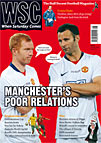 ESPN’s purchase of Premier League games is not their first brush with football. David Wangerin traces a complicated relationship
ESPN’s purchase of Premier League games is not their first brush with football. David Wangerin traces a complicated relationship
In America, ESPN (Entertainment Sports Programming Network) is generally the most indispensable channel in the house; in the UK it’s just another satellite option. Whether the acquisition of Premier League rights will help the self-proclaimed “Worldwide Leader in Sports” to find greater favour over here is open to question. But its association with English football goes back further than even its Wikipedia entry is prepared to acknowledge.
It was public television that, beginning in 1976, gave English football its first real run-out in the US: hour-long highlights gleaned from British TV and repackaged as All Star Soccer. Though the series endured for several years, it wasn’t seen in all parts of the country and not that many ever knew of its existence. By the end of the decade, the NASL had secured a more conspicuous contract with ABC and was trumpeting itself as the “sport of the Eighties”. Fans, it was assumed, would be more interested in the New York Cosmos than Chelsea.
At that time, ESPN was just a blip on a dark screen. It had come to life in September 1979, surviving largely on peripheral events. Early line-ups leaned heavily on boxing, horse racing and minor collegiate sports, with business reports in the morning and aerobic workouts for the industrious. Some of its programming, though, was distinctly more exotic: Gaelic sports, Australian rules football – and a chance to follow the FA Cup.
This wasn’t the first time an American network had taken an interest in the latter competition; back in 1961 ABC had shown the whole of the final between Spurs and Leicester on its Wide World of Sports series a few weeks after it was played. But ESPN’s presentation of West Ham’s win over Arsenal in the 1980 final – in its entirety, from the BBC broadcast – might have been the first time Americans saw English football as the English did.
The following season, the network introduced a British-produced “Road to Wembley” package, which featured hour-long highlights of a Cup-tie fractured with commercial breaks. Lacking anything like a set time-slot, the road proved tortuous, but the vigilant few were handsomely rewarded. Anyone who heard, for example, Barry Davies exclaim his way through a sixth-round tie between Leicester City and Shrewsbury Town in March 1982 would doubtless agree: Leicester went through three goalkeepers and came from behind to win, 5-2. (UK ESPN viewers have more recently seen these and other ties on its Classic channel.)
Greater pleasures soon followed. Two months later, the network took a live feed from the BBC to bring America Breakfast at Wembley, the first time an English match had appeared live on commercial TV. That Spurs and QPR failed to resolve a 1‑1 deadlock was hard luck on the US audience; the replay wasn’t shown live, and neither was the one between Brighton and Manchester Utd the following season. All the same, ESPN seemed to be warming to soccer: as well as Road to Wembley, it had broadcast English league matches and internationals, the NASL, parts of the 1982 World Cup and even the Bundesliga.
What it really wanted, though, was big-ticket American stuff – and once it got it, soccer paid the price. In 1983 ESPN bagged rights to pro basketball and helped to spawn a new professional gridiron league; without warning, the Road to Wembley disappeared. Major League Baseball and NFL contracts soon followed, and the network began to gear its programming to the promotion of these leagues at the expense of competition in less familiar sports. By 1993, when it decided to hold its own awards ceremony (“the nominees for Best Team are…”), it was clear it was taking itself too seriously.
Today, ESPN has 45 channels serving 200 counties and affixes its four letters to everything from magazines to online games. Its fingers are in all three of America’s major sports as well as college gridiron and basketball, and NASCAR. But today’s focus is as much on “entertainment” as “sports”: phone-ins, quiz shows, docu-dramas and some pointlessly frothy musings (such as a daily show called Who’s Now).
While the network has remained a steadfast presenter of Major League Soccer (MLS) and holds rights to the next two World Cups, how much affection it has for the game is open to question. Its MLS coverage is perfunctory, and presenters of other programmes have been known to lob in the occasional anti-soccer grenade – pandering, it would seem, to the network’s core audience. One of the network’s top “personalities”, the perpetually voluble Jim Rome, is notorious for his antipathy toward the game.
Whether this should matter to the Premier League is moot. The survival of Setanta’s North American arm notwithstanding, US rights belong to something called the Fox Soccer Channel – and Rupert Murdoch.
From WSC 270 August 2009